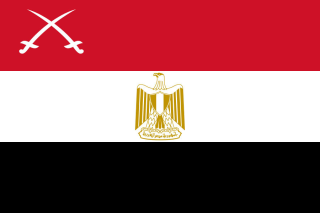| Second Field Army | |
|---|---|
| Active | November 1968 – present |
| Country | |
| Type | Field army |
| Size | approximately 120,000 active personnel |
| Part of | Unified Command of the Area East of the Canal |
| Headquarters | Ismailia |
| Nickname(s) | Second Army/ El-Geish el-Thany |
| Colors Identification | Red, White and Black |
| Anniversaries | 6 October 1973 |
| Engagements | |
| Commanders | |
| Army Commander | Lieutenant-General Rafiq Raafat Arafat |
| Notable commanders | Mohamed Abdel Ghani el-Gamasy Saad Mamoun Fouad Aziz Ghali Ibrahim El-Orabi Mohammed Hussein Tantawi |
The Second Field Army is a military formation of the Egyptian Army, formed in 1968. [1] [2] Army headquarters is at Ismailia. It is usually commanded by a field commander of lieutenant-general rank of at least 34 years' service, and reports directly to the Army General Headquarters and General Staff.
Contents
- Twenty-first century
- Operation Badr Order of Battle, 1973
- Formations in 2018
- Previous Commanders
- References
- See also
During the 1973 Yom Kippur War against Israel, the army commander was Lieutenant General Saad Mamoun. The army's troops crossed the Suez Canal during Operation Badr, the opening offensive of the war, along with the Third Army.
Just before the Battle of the Chinese Farm in 1973, it included on its southern flank the 21st Armoured Division commanded by Brigadier General Ibrahim El-Orabi and the 16th Infantry Division commanded by Brigadier General Abd Rab el-Nabi Hafez. In addition to being division commander Hafez also commanded forces within his division's bridgehead over the Suez Canal, which included the 21st Armoured Division. Orabi's unit included the 1st Armoured Brigade commanded by Colonel Sayed Saleh, the 14th Armoured Brigade commanded by Colonel Othman Kamel, and the 18th Mechanized Brigade commanded by Colonel Talaat Muslim. Hafez's 16th Division included the 16th Infantry Brigade, commanded by Colonel Abd el-Hamid Abd el-Sami', as well as the 116th Infantry and the 3rd Mechanised Brigades. [3]
Trevor N. Dupuy writes the 182nd Parachute Brigade was assigned to Second Army. [4] After the Battle of the Chinese Farm, Ismaila was under threat. The 182nd Parachute Brigade, comprising the 81st, 85th and 89th Battalions (each composed of three companies) under the command of Colonel Ismail Azmy, was assigned responsibility for defending the area south of Ismailia against an Israeli offensive. Azmy arrived at Nafisha with the bulk of his brigade at midnight on October 17, where he was briefed by Brigadier General Abd el-Munim Khalil, commander of Second Army. Khalil identified the west bank strong points as objectives for the paratroopers to secure, as the ramparts could be used to provide fire support to Egyptian forces on the east bank. The paratroopers would also hold Serabaeum and the bridges there over the Sweetwater Canal. [5] [6]











